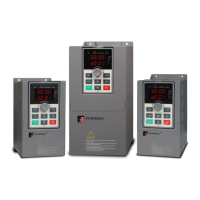14 / 16
Output terminal status of the third(at
last) fault
Power-on time of the third(at last)
fault
Running time of the third(at last) fault
Frequency of the second fault
Current of the second fault
Bus voltage of the second fault
Input terminal status of the second
fault
Output terminal status of the second
fault
Power-on time of the second fault
Running time of the second fault
Frequency of the first fault
Running time at first failure
8. Fault alarm and countermeasures
PI500A can provide effective protection when the equipment performance is played fully. In case of
abnormal fault, the protection function will be invoked, the inverter will stop output, and the faulty relay
contact of the inverter will start, and the fault code will be displayed on the display panel of the inverter. Before
consulting the service department, user can perform self-check , analyze the fault cause and find out the
solution according to the instructions of this chapter. If the fault is caused by the reasons as described in the
dotted frame, please consult the agents of inverter or directly contact with our company.
1.The short circuit of inverter output
happens
2.The wiring for the motor and the
inverter is too long
3.Module overheating
4.The internal wiring of inverter is
loose
5.The main control panel is abnormal
6.The drive panel is abnormal.
7.The inverter module is abnormal
1.Eliminate peripheral faults
2.Additionally install the reactor or
the output filter
3.Check the air duct is blocked or
not and the fan is working normally
or not, and eliminate problems
4.Correctly plug all cables
5.Seek for technical support
1.The acceleration time is too short
2.Manual torque boost or V/F curve is
not suitable
3.The voltage is low
4.The short-circuit or earthing of
inverter output happens
5.The control mode is vector and
without identification of parameters
6.The motor that is rotating is started
unexpectedly.
7.Suddenly increase the load in the
process of acceleration.
8.The type selection of inverter is
small
1.Increase acceleration time
2.Adjust manual torque boost or
V/F curve
3.Set the voltage to the normal
range
4.Eliminate peripheral faults
5.Perform identification for the
motor parameters
6.Select Speed Tracking Start or
restart after stopping the motor.
7.Cancel the sudden load
8.Choose the inverter with large
power level
1.The short-circuit or earthing of
inverter output happens
2.The control mode is vector and
without identification of parameters
3.The deceleration time is too short
4.The voltage is low
5.Suddenly increase the load in the
process of deceleration.
6.Didn't install braking unit and
braking resistor
1.Eliminate peripheral faults
2.Perform identification for the
motor parameters
3.Increase the deceleration time
4.Set the voltage to the normal range
5.Cancel the sudden load
6.Install braking unit and brake
resistor
Constant speed
overcurrent
1.The short-circuit or earthing of
inverter output happens
2.The control mode is vector and
without identification of parameters
3.The voltage is low
4.Whether suddenly increase the load
when running
5.The type selection of inverter is
small
1.Eliminate peripheral faults
2.Perform identification for the
motor parameters
3.Set the voltage to the normal range
4.Cancel the sudden load
5.Choose the inverter with large
power level
1.Didn't install braking unit and
braking resistor
2.The input voltage is high
3.There is external force to drag the
motor to run when accelerating.
4.The acceleration time is too short
1.Install braking unit and brake
resistor
2.Set the voltage to the normal range
3.Cancel the external force or
install braking resistor.
4.Increase acceleration time
1.The input voltage is high
2.There is external force to drag the
motor to run when decelerating.
3.The deceleration time is too short
4.Didn't install braking unit and
braking resistor
1.Set the voltage to the normal range
2.Cancel the external force or
install braking resistor.
3.Increase the deceleration time
4.Install braking unit and brake
resistor
Constant speed
overvoltage
1.There is external force to drag the
motor to run when running
2.The input voltage is high
1.Cancel the external force or
install braking resistor.
2.Set the voltage to the normal range
The range of input voltage is not
within the specification
Adjust the voltage to the range of
the requirements of specification
1.The momentary power cut
2.The inverter's input voltage is not
within the specification
3.The bus voltage is not normal
4.The rectifier bridge and buffer
resistance are abnormal
5.The drive panel is abnormal.
6.The control panel is abnormal
1.Reset fault
2.Adjust the voltage to the normal
range
3.Seek for technical support
1.The type selection of inverter is
small
2.whether the load is too large or the
motor stall occurs
1.Choose the inverter with large
power level
2.Reduce the load and check the
motor and its mechanical
conditions
1. power grid voltage is too low
2.whether the setting motor protection
parameters (F8.03) is appropriate or
1.Check the power grid voltage
2.Correctly set this parameter.
3.Reduce the load and check the

